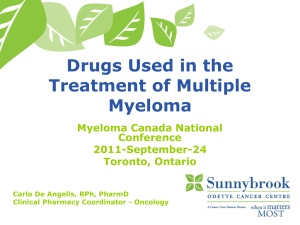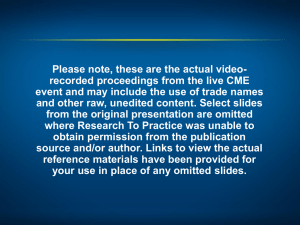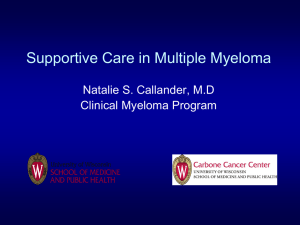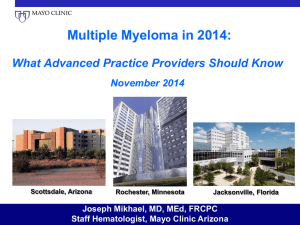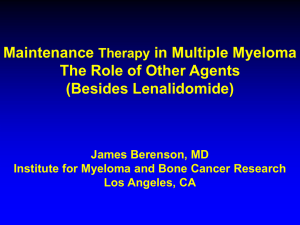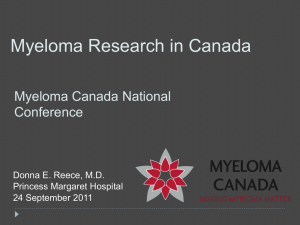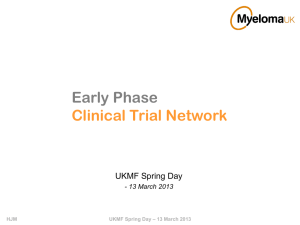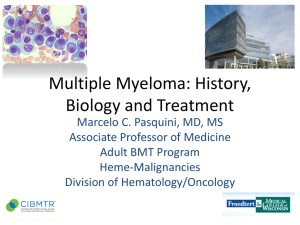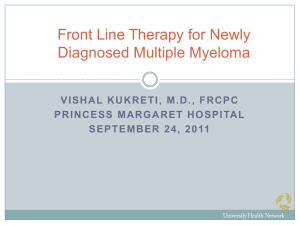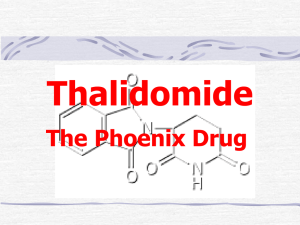L.K.-44 yo F with multiple myeloma and Sweet`s syndrome
advertisement
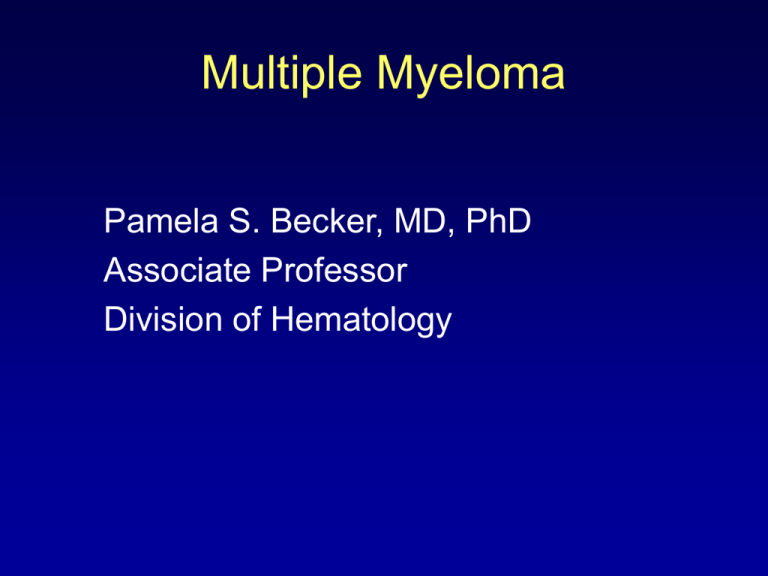
Multiple Myeloma Pamela S. Becker, MD, PhD Associate Professor Division of Hematology Case I: 44 yo F • 17 mo ago back pain • 12 mo ago skin rash-annular then maculopapular erythematous rash that was biopsied R shoulder, then a second biopsy posterior arm. Involved face, neck, arms, chest. Occasional pruritus. Case I, cont’d • Sweet’s syndrome-Prescribed Prednisone 6 mo. Prior, 40 mg, then 2 mo. prior, 20 mg • Sudden onset severe back pain 7/04-ambulance to hosp • LABS: CBC: WBC 6.2, hemoglobin 10.6, hematocrit 31.1, platelet count 232K • Urinalysis: 3-5 white cells, Leuk esterase, 1+ protein, E.Coli • Chem: BUN 40, creatinine 2.0, uric acid 11.6, calcium 13.5, albumin 2.8, total bilirubin 0.18, alk phos 153, AST 35, ALT 40. TP 12.3, gamma globulin 6.2, Monoclonal protein 5.8 gm/dl IgA kappa • CT scans: 3.5 x 1.5 cm mass in the post L chest, a mass in the right psoas, L1-L3, • Bone marrow biopsy performed:80-90% plasma cells MRIs • L-spine: mass displacing right psoas muscle laterally involving L1 and L2 neural foramina on the right, with possible erosion of L2 right lateral vertebral margin. • T spine: comp fx of T5, T10, L1, and L2 • C spine: 3 x 3 cm mass. Therapy • 7-04-Chemotherapy • 75 mg Doxorubicin, 1200 mg Cytoxan, 2 mg vincristine, Dexamethasone 4 mg qid, and Aredia 30 mg X 2 • ANC 0.2 on day 7Neupogen 300 mcg then 480 mcg • RBC-4 units • Seen on day 12-Recurrent rash, WBC 3.76, beta2 microglobulin 2.4 Next therapy • Thalidomide/Dex began 8/04 • MRI end 9/04: mass L2 to L3 vertebral region 4.6 X 3.1 x 0.8 cm. R L2 and L3 neural foramina, ? R L3 nerve root. Comp fx L3, L4, L5. L lat sacrum enhancing lesion 2.5 X 2 cm. • Chest CT: cardiomegaly, mid T vertebrae sclerotic changes,comp fx, acute kyphotic deformity, possible fx through body of sternum. • Monoclonal protein 5.8 (7/21)2.6 (7/28), 0.4 8/30, 0.6 (10/14), 0.9 (2/10) • Radiation to L spine • Began Velcade/Doxil-monoclonal protein down to 0.8 post first cycle, now s/p 2nd cycle Next treatment: Tandem transplant • Auto • Mini allo from HLA matched sister Multiple Myeloma: Incidence and Epidemiology • 1% of all malignancies • 10% of hematological malignancies (2nd most common) • 3-4 per 100,000 population • 16,000 new cases/yr; 11,000 deaths/yr • Median age: 65 yo; 3%<40 yo • M>F • Risk: radiation exposure Myeloma: Pathogenesis International Working Group Classification • Monoclonal gammopathy of undetermined significance (MGUS) • Asymptomatic (Smouldering) myeloma • [Indolent myeloma] • Symptomatic myeloma • Non-secretory myeloma • Solitary plasmacytoma of bone • Extramedullary plasmacytoma • Multiple, recurrent plasmacytomas • Plasma cell leukemia Multiple myeloma: Symptoms • • • • • • Fatigue Back pain Increased infections Hypercalcemia Renal insufficiency Hyperviscosity Multiple Myeloma: Diagnosis • Bone marrow containing more than 10% plasma cells or a plasmacytoma, plus at least one of the following: 1) a monoclonal protein in the serum, usually more than 30 g/L 2) a monoclonal protein in the urine OR 3) lytic bone lesions Bone Marrow Plasma Cells Bone marrow plasmacytosis Serum Protein Electrophoresis (SPEP) M-protein Albumin 1 2 κ λ Rouleaux on peripheral smear Multiple Myeloma: Durie-Salmon Staging Multiple myeloma: New staging (International Staging System) • Based on Beta 2 microglobulin and albumin I. β2M <3.5 + Alb ≥ 3.5 Med surv 62 m II. In between Med surv 44 m III. β2M >5.5 Med surv 29 m Multiple Myeloma: Indication for Treatment: CRAB • • • • Calcium (Hypercalcemia) Renal insufficiency Anemia Bone lesions Monoclonal Gammopathy of Uncertain Significance • Often Benign; Over Many Years May Eventually Develop Into Myeloma or Other Lymphoproliferative Disorders; May Be Associated With Tumors – Monoclonal Gammopathy – M-component Level • Igg < 3.5 G/dl • Iga < 2.0 G/dl • BJ Protein < 1.0 G/24 H – Bone Marrow Plasma Cells < 10% – No Bone Lesions – No Symptoms Non secretory myeloma – no secretion of protein (relatively rare if serum and urine carefully studied for presence of Mprotein) – prognosis same as myeloma or longer Plasmacytoma • Solitary plasmacytoma of bone – Usually progress, slowly, to myeloma • Extramedullary plasmacytoma – Upper respiratory tract including nasal cavity, sinuses, nasopharynx, larynx; other sites possible – some progress to myeloma Plasma cell leukemia – loss of adhesion molecules that localize in marrow (CD56, VLA-5, MPC-1) – greater than 20% plasma cells in blood and > 2000/ul – more frequent: younger age, hepatosplenomegaly, lymphadenopathy, few lytic lesions, small M-protein, poor prognosis Amyloidosis • Amyloid: homogenous, amorphous extracellular material with fibrillar structure; made of low MW proteins that precipitate in tissues Amyloidosis, cont’d • Reactive systemic amyloidosis: – Amyloid protein A derived from catabolism of serum amyloid Arelated protein (SAA), an acute phase protein; excess production in chronic inflammatory or infectious disorders, may result in deposition in tissues • Amyloid Due to an Immunologic-related Disorder – Insoluable Catabolic Product of the Variable Region of a Light Chain, Lambda; – May Occur As a Result of Myeloma or Waldenstrom’s Macroglobulinemia • Primary Amyloidosis – Deposits in Joint Capsules, Ligaments, Tongue, Heart (CHF), GI Tract (Diarrhea), Peripheral Nerves (Paresthesias, Weakness, Orthostatic Hypotension), Small Vessel Fragility From Amyloid in Walls (Purpura), Factor X Deficiency Due to Its Binding in the Extracellular Tissues Organ involvement by amyloidosis POEMS (polyneuropathy, organomegaly, endocrinopathy, M-protein, skin changes) – Peripheral neuropathy usually first sign – Papilledema, hyperpigmentation, organomegaly – < 5% plasma cells in marrow – Association with Castleman’s disease – Anemia, rare; usually Hct normal or polycythemia, thrombocytosis – Single lytic lesions improved with radiation; may have neurologic improvement as well – Gynecomastia, atrophic testes, clubbing Case 2-57 yo F • • • • • • • Referred for eval of leukopenia (WBC 3) WBC 5.27, hgb 12.8, platelets 231K ANA neg SPEP 0.3 g/dl monoclonal IgG lambda Quantitative Bence Jones: Negative Skeletal survey: Negative Bone marrow: Lambda restricted plasma cells 0.6% by flow; 6% by morphology with rare multinucleated plasma cells and some with prominent nucleoli • DIAGNOSIS: ___________ • Follow-Up: 18 months later: SPEP: 0.4 g/dl Case 3-48 yo Hisp M • Right femur fracture on Orthopaedics • Flow from OR specimen: 2.9% clonal plasma cells • SPEP 1.3 g/dl monoclonal IgG kappa, also IgA lambda two bands • UPEP: same as above, and faint kappa light chains • Bone marrow: 47% plasma cells Case 3 cont’d • Enrolled on Southwest Oncology Group Trial of Lenalidomide vs. Placebo + Dexamethasone • Follow up studies at 3 months: SPEP: progressive decline, down to 0.8 g/dl. Bone marrow plasmacytosis: 15-20% plasma cells • 10 months: 0.5 g/dl • 11 months: 0.7 g/dl Case 4: 51 yo M • Running track, developed back pain, difficulty walking • CT scan: L1 lytic lesion 1.9 X 2.3 cm • Needle biopsy: Clonal plasma cells • SPEP negative, UPEP negative • Bone marrow survey by MRI negative • PET scan negative • DIAGNOSIS: ____________ • Treatment: Radiation Therapy • Future: 80% of vertebral plasmacytomas myeloma Multiple Myeloma: Therapy • • • • • • • • Melphalan/Prednisone VAD (now DVD) Thalidomide/Dexamethasone Lenalidomide/Dexamethasone Bortezomib and combinations Autologous Stem Cell Transplant Minimal myeloablative Allogeneic Transplant Tandem Transplants Use of Dexamethasone With or Without Thalidomide in Frontline Therapy • ECOG E1A00: phase 3, randomized, controlled trial Repeated monthly for 4 mos Newly diagnosed, untreated symptomatic MM (N = 207) Thal/Dex arm Thalidomide 200 mg/day PO + Dexamethasone 40 mg/day on Days 1-4, 9-12, 17-20 CR/PR/ Stable (n = 103) Dex alone arm Dexamethasone 40 mg/day on Days 1-4, 9-12, 17-20 Stop therapy Any progression (n = 104) Note: Use of prophylactic anticoagulant not required. Rajkumar V, et al. ASH 2004. Abstract 205. Stem-cell transplant or continue therapy at physician’s discretion Use of Dexamethasone With or Without Thalidomide in Frontline Therapy Response after 4 cycles Grade 3 or 4 toxicity ThaI/Dex (n = 99) Dex alone (n = 100) ThaI/Dex (n = 102) Dex alone (n = 102) 100 Patients (%) 80 70 73% 80 63% 60 50 90 P = .002 Patients (%) 90 100 50% 41% 40 70 60 50 30 30 20 20 4% 10 0 Response* Corrected Response† 0% Complete Response * ↓ in serum M protein and urine M protein † ↓ in serum M protein (no available urine M protein) Rajkumar V, et al. ASH 2004. Abstract 205. 34% 40 10 0 17% 18% 3% DVT Gr > 3 7% 4% Neuropathy All Gr > 4 Gr > 3 toxicity 11% 7% Deaths Use of Melphalan Plus Prednisone With or Without Thalidomide in Frontline Therapy • Interim analysis of prospective, randomized trial MPT arm Oral melphalan 4 mg/m2 (7 days/mo) Prednisone 40 mg/m2 (7 days/mo) Thalidomide 100 mg/day (continuously) Newly diagnosed elderly myeloma patients Median age, 72 yrs (60-85) (N = 177 ) (n = 89) MP arm Oral melphalan 4 mg/m2 (7 days/mo) Prednisone 40 mg/m2 (7 days/mo) (n = 88 ) Palumbo A, et al. ASH 2004. Abstract 207. 6 mos Use of Melphalan Plus Prednisone With or Without Thalidomide in Frontline Therapy 100 90 Response (%) 80 Progression 8.4% 28% 14.5% Partial response (50-99*) 70 60 50 40 49.4% 77.1% PR (50-74*) 15.6% CR+nCR 25.3% PR (75-99*) 33.8% 30 41.3% 20 10 No response (0-50*) 5.4% MPT Palumbo A, et al. ASH 2004. Abstract 207. PR (50-74*) 28% PR (75-99*) 13.3% 27.7% 0 * % reduction in baseline M protein MP New Agents: Lenalidomide • New agents needed to address concerns regarding high rate of nonhematologic toxicity seen with thalidomide • CC-5013 (lenalidomide) is a potent analogue of thalidomide – Promising results in relapsed or refractory MM – Significantly fewer nonhematologic toxicities • Less peripheral neuropathy, constipation, sedation – However, associated with neutropenia and thrombocytopenia CC-5013 (Lenalidomide) Thalidomide Bortezomib With and Without Dexamethasone in Frontline Therapy • Phase 2 study evaluated use of bortezomib later supplemented with dexamethasone to boost response in newly diagnosed patients with MM • Treatment schedule – Bortezomib (1.3 mg/m2, twice weekly for 2 wks) • Administered every 3 wks for up to 6 cycles • Given alone for first 2 cycles – Dexamethasone (40 mg/day) on day of and day after bortezomib • Added after 2 cycles if < partial response • Added after 4 cycles if < complete response Jagannath S, et al. ASH 2004. Abstract 333. Combination Bortezomib, Thalidomide, Plus Dexamethasone (VTD) in Frontline Therapy – Thalidomide (100-200 mg/day) – Dexamethasone (20 mg/m2) PO Days 1-4, 9-12, 17-20 – Bortezomib (1.0, 1.3, 1.5, 1.7, 1.9 mg/m2) Days 1, 4, 8, 11 – Every 4 wks for 2-3 cycles Alexanian R, et al. ASH 2004. Abstract 210. P = .04 100 Response Rate*, % • Phase 1/2 trial of frontline bortezomib combined with thalidomide + dex • 30 previously untreated patients with MM received 94% P = .18 80% 80 68% 64% 60 40 20 0 TD All doses alone† †Historical ≤ 1.3 ≥ 1.5 VTD controls from nonrandomized study * Stringent response criteria: ≥ 75% reduction in serum M protein ≥ 95% reduction in Bence Jones protein Pulsed Melphalan, Dexamethasone, and Thalidomide in Frontline Therapy • Multicenter, phase 2 study of pulsed melphalan, dexamethasone, and thalidomide in 50 elderly patients with untreated, symptomatic MM – ≥ 75 yrs of age – Poor performance status (58% had PS ≥ 2) – Advanced-stage disease (58% had ISS 3) • Treatment schedule (3 courses every 5 wks, all oral) – Melphalan (8 mg/m2) Days 1-4 – Dexamethasone (12 mg/m2) Days 1-4 and 14-18 • Intensity less than half that of standard high-dose dexamethasone – Thalidomide (300 mg) Days 1-4 and 14-18 • Intermittent dosing used Dimopoulos MA, et al. ASH 2004. Abstract 1482. Pulsed Melphalan, Dexamethasone, and Thalidomide in Frontline Therapy • 68.2% of patients responded – Partial response, 61.4% – Complete response, 6.8% – Median time to response, 2 mos (range 0.5-14.0) • Generally well tolerated – 25 infectious episodes • 1 fatality Dimopoulos MA, et al. ASH 2004. Abstract 1482. • Other adverse events – Gr 3/4 neutropenia (15%) – Gr 3/4 thrombocytopenia (10%) – Somnolence (35%) – Constipation (30%) – Tremors (25%) – Xerostomia (15%) – Headaches (10%) – DVT (10%) – Peripheral neuropathy (10%) Treatment of Relapsed/Refractory Multiple Myeloma Bortezomib vs Dexamethasone in Relapsed/Refractory Multiple Myeloma • APEX: international, phase 3, randomized trial Bortezomib Arm Stratified by: • No. of prior therapies • Refractory disease • B-2 microglobulin Patients with relapsed or refractory MM (N = 669) Induction: 1.3 mg/m2 IV Days 1, 4, 8, 11 q3 wks for 8 cycles Maintenance: 1.3 mg/m2 IV Days 1, 8, 15, 22 q5 wks for 3 cycles (n = 333) Dexamethasone Arm Induction: 40 mg PO Days 1-4, 9-12, 17-20 q5 wks for 4 cycles Maintenance: 40 mg PO Days 1-4 q4 wks for 5 cycles (n = 336) Total days on therapy: 278 for bortezomib and 280 for dexamethasone Trial halted 1 year early by data monitoring committee due to superiority of bortezomib arm Richardson P, et al. ASH 2004. Abstract 336.5. Bortezomib vs Dexamethasone in Relapsed/Refractory Multiple Myeloma 78% improvement in median time to progression (TTP) with bortezomib 1.0 Median TTP Bortezomib Dexamethasone Proportion of patients 0.9 0.8 All Pts 6.2 mos 3.5 mos Pts 1 relapse* 7.0 mos 5.6 mos 0.7 * Patients treated as secondline, after first relapse 0.6 0.5 0.4 P = .0001 0.3 Bortezomib Dexamethasone 0.2 0.1 0.0 0 30 60 90 120 150 180 210 240 270 300 330 360 390 420 450 Time (days) Richardson P, et al. ASH 2004. Abstract 336.5. Bortezomib vs Dexamethasone in Relapsed/Refractory Multiple Myeloma 41% decreased risk of death with bortezomib 1.0 P = .005 Proportion of patients 0.9 0.8 0.7 0.6 0.5 0.4 0.3 Bortezomib Dexamethasone 0.2 0.1 1-yr survival Bortezomib Dexamethasone All Pts 80% 66% Pts 1 relapse* 89% 72% * Patients treated as secondline, after first relapse 0.0 0 30 60 90 120 150 180 210 Time (days) Richardson P, et al. ASH 2004. Abstract 336.5. 240 270 300 330 360 MYELOMA: STEM CELL TRANSPLANT Conventional Dose Chemo vs. Auto Transplant in Multiple Myeloma Tandem Auto Transplant Auto then mini Allo Figure 4. Kaplan-Meier estimates of overall survival and progression-free survival following nonmyeloablative allografts for myeloma Maloney, D. G. et al. Blood 2003;102:3447-3454 Copyright ©2003 American Society of Hematology. Copyright restrictions may apply. BMT Clinical Trials Network • Tandem Auto VS • Auto then mini-Allo (if have an HLAidentical sibling)
